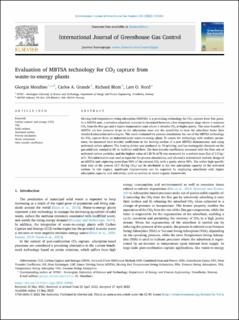| dc.contributor.author | Mondino, Giorgia | |
| dc.contributor.author | Grande, Carlos Adolfo | |
| dc.contributor.author | Blom, Richard | |
| dc.contributor.author | Nord, Lars O. | |
| dc.date.accessioned | 2022-05-30T12:34:08Z | |
| dc.date.available | 2022-05-30T12:34:08Z | |
| dc.date.created | 2022-05-13T11:22:20Z | |
| dc.date.issued | 2022 | |
| dc.identifier.citation | International Journal of Greenhouse Gas Control. 2022, 118 . | en_US |
| dc.identifier.issn | 1750-5836 | |
| dc.identifier.uri | https://hdl.handle.net/11250/2996862 | |
| dc.description.abstract | Moving bed temperature swing adsorption (MBTSA) is a promising technology for CO2 capture from flue gases. In a MBTSA unit, a selective adsorbent material is circulated between a low-temperature stage where it removes CO2 from the flue gas and a higher-temperature zone where it desorbs CO2 at higher purity. The main benefits of MBTSA are low pressure drops in the adsorption zone and the possibility to heat the adsorbent faster than standard adsorption technologies. This work evaluated via process simulations the use of the MBTSA technology for CO2 capture from an industrial-scale waste-to-energy plant. To assess the technology with realistic parameters, we measured heat transfer coefficients in the heating section of a new MBTSA demonstrator unit using activated carbon spheres. The heating device was produced by 3D printing, and has rectangular channels on the gas-solid side rotated at 45° to facilitate solid flow. The heat transfer coefficients increased with the flow rate of activated carbon particles, and the highest value of 120 W/m²K was measured for a sorbent mass flux of 3.5 kg/m²s. This information was used as input for the process simulations, and allowed a tailored and realistic design of an MBTSA unit capturing more than 90% of the exhaust CO2 with a purity above 95%. The rather high specific heat duty of the process (5.7 MJ/kg CO2) can be attributed to the low adsorption capacity of the activated carbon. In this respect, significant improvements can be expected by employing adsorbents with higher adsorption capacity and selectivity, such as zeolites or metal-organic frameworks. | en_US |
| dc.language.iso | eng | en_US |
| dc.publisher | Elsevier | en_US |
| dc.rights | Navngivelse 4.0 Internasjonal | * |
| dc.rights.uri | http://creativecommons.org/licenses/by/4.0/deed.no | * |
| dc.subject | Heat transfer coefficient | en_US |
| dc.subject | Waste incinerator | en_US |
| dc.subject | Process simulation | en_US |
| dc.subject | Activated carbon | en_US |
| dc.subject | Solid sorbent | en_US |
| dc.subject | TSA | en_US |
| dc.subject | Carbon capture and storage (CCS) | en_US |
| dc.title | Evaluation of MBTSA technology for CO2 capture from waste-to-energy plants | en_US |
| dc.title.alternative | Evaluation of MBTSA technology for CO2 capture from waste-to-energy plants | en_US |
| dc.type | Peer reviewed | en_US |
| dc.type | Journal article | en_US |
| dc.description.version | publishedVersion | en_US |
| dc.rights.holder | © 2022 The Author(s). Published by Elsevier Ltd. | en_US |
| dc.source.pagenumber | 17 | en_US |
| dc.source.volume | 118 | en_US |
| dc.source.journal | International Journal of Greenhouse Gas Control | en_US |
| dc.identifier.doi | 10.1016/j.ijggc.2022.103685 | |
| dc.identifier.cristin | 2024302 | |
| dc.relation.project | Norges forskningsråd: 267873 | en_US |
| dc.source.articlenumber | 103685 | en_US |
| cristin.ispublished | true | |
| cristin.fulltext | original | |
| cristin.qualitycode | 1 | |

